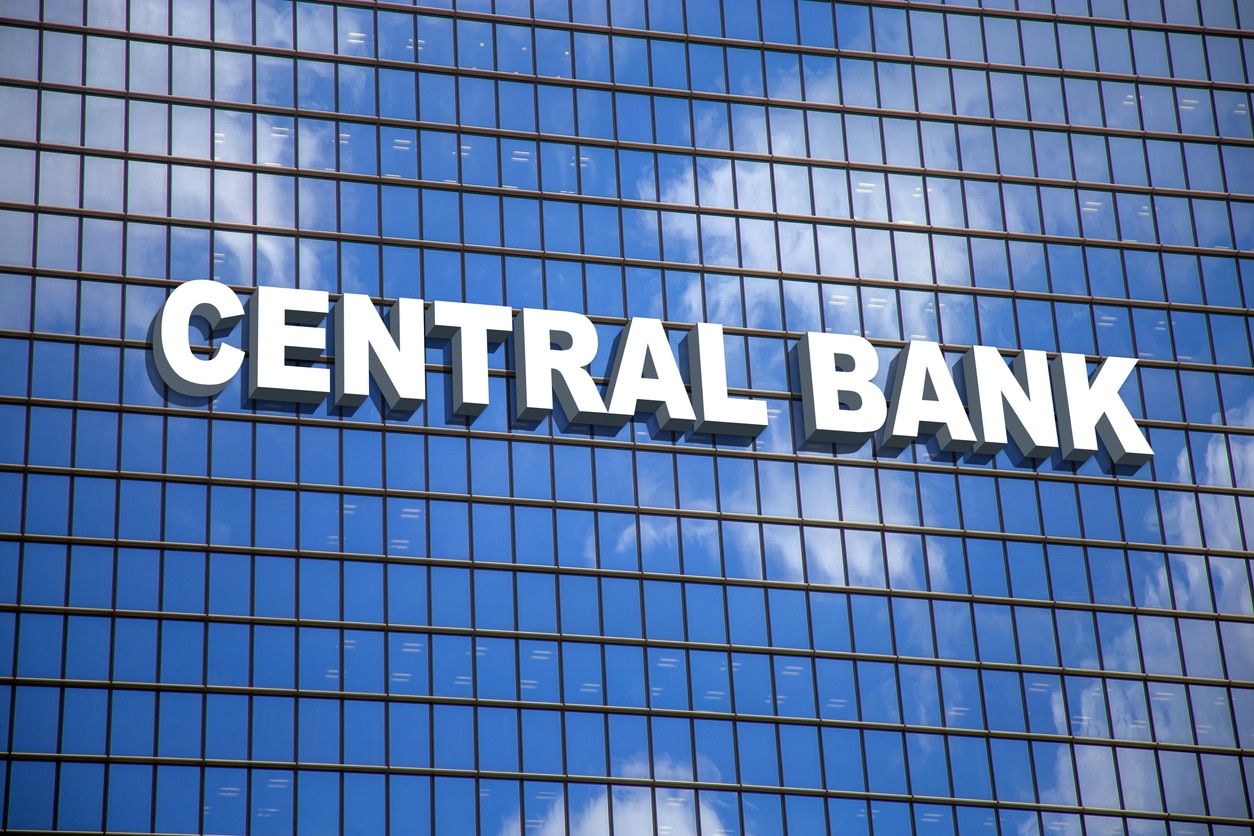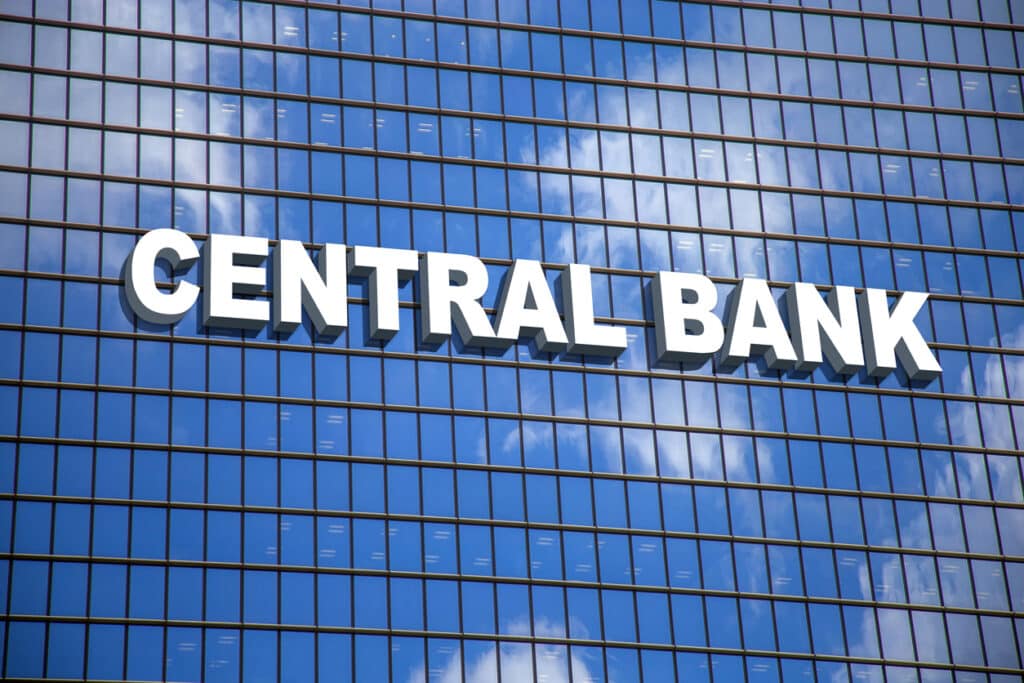

Many factors can affect the value of a currency. Global macroeconomic trends are influential, while political developments and fiscal policy also have a part to play. However, the primary driver of an economy is the monetary policy of the central bank. A central bank will use various monetary policy tools to guide an overheated or undercooked economy towards the broadly accepted aim of a steady state of growth. Most commonly, that is achieved through adjustments in interest rates.
Rising interest rates impact the domestic economic outlook and, subsequently, a currency’s value. Comparing the interest rate policy of different central banks will determine how the various currencies perform on foreign exchange markets. We will explore the functions of central bank systems, the policies employed, and how they impact the global economy and forex markets.
WHAT ARE CENTRAL BANKS?
We need to start by looking at what central banks are and what they do. The role of the central banks has developed over the past few centuries into what is now broadly accepted as their primary function, to provide financial and price stability to a domestic economy.
A central bank acts as the “lender of last resort” as it provides the bedrock of the domestic financial system. The base interest rates they set are used as the benchmark from which domestic financial institutions determine the interest rates they charge (and therefore help to determine their profitability). This then filters through the economy as the commercial interest rates impact consumer bank accounts and debt. That either helps to heat up or cool down economic activity. The outlook for domestic assets such as bonds, equities and the currency will subsequently be driven by the interest rate policy of the central bank.
A central bank has conventional tools, such as interest rate policy and unconventional ones, such as asset purchases and foreign exchange interventions.
Related Articles
- Introduction to the Forex Market
- Interest Rates and Volatility
- Forex and the Yield Curve: Understanding Interest Rates
- Setting the level of interest rates is the conventional monetary policy tool at the disposal of a central bank. Higher interest rates will increase borrowing costs for the economy while encouraging savers to squirrel their money away. This subsequently acts as a chokehold on the economy, helping to reduce activity and bring inflation down. The higher interest rates attract currency buyers, so the currency strengthens.
- Conversely, lowering rates will help stimulate an economy by reducing borrowing costs and making investing cheaper. A lower interest rate drives currency weakness amid selling pressure in the search for more favourable returns.
- In recent decades, open market operations such as asset purchases have become an essential tool for central banks. In response to the Global Financial Crisis of the late 2000s, central banks had already slashed interest rates to zero and were looking for something else, so quantitative easing was born. It was an unconventional tool for open market operations. The buying (quantitative easing) or selling (quantitative tightening) of government securities from financial institutions has since become a popular tool for central banks.
- Buying securities acts as an injection into the economy, increasing the money supply in an attempt to stoke the fires of the economy. However, the increase in the money supply in an effort to create inflation also dilutes the currency and subsequently weakens its value. Selling government securities would act as a withdrawal of liquidity from the system, reducing the money supply and helping to strengthen the value of a currency.
- Foreign exchange interventions are another way the central bank can affect the economy and currency stability. Central banks can buy or sell their domestic currency to strengthen or weaken it. For example, the Bank of Japan will often look to intervene to prevent the Japanese yen from weakening too much. Buying the yen helps to stabilise the value of the currency.
WHAT ARE MAJOR CENTRAL BANKS?
If a country has its own currency, the central bank will set monetary policy. However, in the global economy, some currencies and central banks are considered more important than others. That may be due to historical status or the size of the economy. There are arguably eight major currencies and, therefore, eight major central banks that forex traders should be watching:
- Federal Reserve (the US central bank, also known as the Fed)
- European Central Bank (ECB)
- Bank of Japan (BoJ)
- Bank of England (BoE)
- Bank of Canada (BoC)
- Reserve Bank of Australia (RBA)
- Reserve Bank of New Zealand (RBNZ)
Swiss National Bank (SNB)
The US dollar is the primary reserve currency of the world. According to the latest Bank of International Settlements Triennial Survey data, the USD is on one side of 88% of all forex trades. Subsequently, the interest rate decisions of the Federal Reserve are critical to forex markets. The Fed’s actions can cause shockwaves to financial assets around the world. If you are new to trading forex and are unaware of the impact that the Fed can have, you should probably find out soon, or you might be in for a bit of a shock.
According to turnover by forex pair, EUR/USD is the most widely traded, accounting for almost 23% of all trades. Subsequently, the ECB is also a vitally important major central bank. EUR trades account for around 30% of the total of all currency trades, meaning that if the USD is not one side of a pair, it is likely that the EUR is. The Bank of Japan and the Bank of England are also considered to be significant actors that impact forex markets.
The other four (the BoC, RBA, RBNZ and SNB) would be considered slightly less important, with a smaller proportion of daily fx flow. Despite this, they are still considered systemically important to the global economy and are therefore classed as major central banks.
However, outside the traditional majors, traders are also increasingly focusing on the People’s Bank of China. Trading in the USD/CNY pair has increased in volume in recent years. In overseeing the yuan, the PBoC helps to drive the Chinese economy, which is the second-largest in the world. Furthermore, it is argued that given the right circumstances, the yuan could become a global reserve currency one day. If so, the PBoC will continue to grow in importance for forex traders and be widely considered a major central bank.
HOW DO CENTRAL BANKS IMPACT THE GLOBAL ECONOMY?
A central bank controls the domestic economy. However, with the intertwined nature of the global economy, what happens in the largest and most influential economies can impact regional economies and sometimes the global economy.
The most obvious example to cite is the US Federal Reserve. The Fed does not make monetary policy decisions based on the world economy (although it could never ignore the broader macro picture). It is mandated to set policy for the United States. However, the US economy is the largest in the world, while the near-ubiquitous US dollar makes its presence felt in almost every corner of the globe.
The decisions that the Fed makes have repercussions for global trade flows. The yields on government bonds (i.e. how much governments have to pay to borrow) will be impacted by the Fed; consequently, this also feeds into exchange rates and forex markets. The impact can be huge.
Aside from the Fed, the central banks of the other major economic hubs will play a role in the outlook for the global economy. China is a huge economy and a dominant force in Asia, having far-reaching implications for international trade. Any pro-growth policy measures implemented by the People’s Bank of China will significantly impact countries that trade directly with China and the global supply chain. The collective size of the Eurozone economy also means that the European Central Bank is also an impor6an6 player.
However, monetary policy functions are not the only important role that central banks play. The financial stability of the global economy is also crucial. During extreme financial stress and economic crises, central banks often act quickly, decisively and often in concert. In recent history, there have been examples where central banks move in lockstep to counter a global economic crisis.
The “credit crunch” of the Global Financial Crisis of the late 2000s drove central banks worldwide to cut interest rates to around zero. The banks also tried additional measures, including quantitative easing and negative interest rates. The liquidity that flooded through the financial system helped nurse the global economy back to health; however, it would be years before central banks felt they could begin normalising interest rates once more (and some never have).

That was until the global pandemic of 2020. As much of the world went into social lockdown, there was an unprecedented global demand shock. Once more, central banks acted in near unison to cut interest rates to zero while governments engaged in substantial fiscal stimulus.
However, as the pandemic lifted and the pendulum swung back, the monetary and fiscal easing generated rampant inflation across the world. Central banks aggressively hiked interest rates in an attempt to moderate inflation. The global economy is still dealing with the effects of the pandemic and the actions of central banks (and governments) years later.
People Also Read
- Currency Carry Trade: Let the Interest Rates Do the Work
- How to Use Futures Open Interest in Forex Trading
- What Can the Fear and Greed Index Tell Us About Forex Markets
HOW DO INTEREST RATE DECISIONS AFFECT FOREX MARKETS?
The level at which a central bank sets its interest rates will significantly impact a currency. If the interest rate increases, it will attract capital flows from investors looking for better returns on their money. That will increase the currency’s value, strengthening it relative to other currencies.
Investors will consider the interest rate and the expectation of the central bank’s policy direction when deciding whether to buy or sell a currency. That is what drives forex markets. Interest rate differentials between countries will play a crucial role in the relative value of currencies in a forex pair. Investment banks and investors look to use interest rate differentials as a trading strategy in forex markets.
The carry trade is a popular currency trading strategy derived from interest rates. It involves borrowing in a low-interest currency and then investing in a currency with a higher interest rate. The interest rate differentials between the two currencies can allow for a long-term buy-and-hold profit (although other factors can also influence the market value of the currencies in the pair).
Central banks can also have a massive impact on forex markets through currency intervention. One of the most famous instances was the Swiss National Bank’s action in 2011. In the aftermath of the Great Financial Crisis and the subsequent Eurozone debt crisis, there was a perception that Switzerland was a haven during the economic turbulence, and capital flooded into the Swiss franc.
To combat its significant strengthening, the SNB set a floor of 1.20 Swiss francs per euro, promising to sell the franc to prevent its appreciation. The floor lasted until 2015 when famously the SNB suddenly stopped the intervention. The value of the Swiss franc soared by +30% almost instantly, causing thunderous volatility in forex markets with shattering consequences for traders and brokers.
SUMMARY
The world’s major central banks play a fundamental role in guiding the global economy and all of our lives. They influence the amount you pay on your mortgage and the return you get on your assets. Central banks and the interest rates they set help to determine the value of currencies and subsequently drive foreign exchange.
Although setting interest rates is not the only way central banks influence forex markets, it is the primary factor traders use as a measuring stick when comparing currencies. As such, the interest rate decisions of central banks are fundamental to the workings of forex markets.
Choose one of our Top Forex Brokers
| Broker | Features | Regulator | Platforms | Next Step | |
|---|---|---|---|---|---|
 73% of retail CFD accounts lose money
Founded: 2014 73% of retail CFD accounts lose money
Founded: 201473% of retail C... |
|
FSA SC | MT4, MT5 | ||
 Your capital is at risk
Founded: 2014 Your capital is at risk
Founded: 2014 |
|
FSPR | MT4 | ||
 Your capital is at risk
Founded: 2006 Your capital is at risk
Founded: 2006Europe* CFDs ar... |
|
ASIC, FSA, FSB, MiFID | MetaTrader4, Sirix, AvaOptions, AvaTrader, Mirror Trader | ||
 Between 74-89% of CFD traders lose
Founded: 2010 Between 74-89% of CFD traders lose
Founded: 2010Between 74-89 % of retail investor accounts lose money when trading CFDs |
|
ASIC, FCA | MetaTrader 4, MetaTrader 5, cTrader | ||
 77% of CFD traders lose
Founded: 2007 77% of CFD traders lose
Founded: 200777 % of retail investor accounts lose money when trading CFDs with this provider. You should consider whether you understand how CFDs work, and whether you can afford to take the high risk of losing your money. |
|
ASIC, CySEC, FCA | eToro Platform | ||
 Your capital is at risk
Founded: 2009, 2015, 2017 Your capital is at risk
Founded: 2009, 2015, 2017 |
|
ASIC, CySEC, IFSC | MT4 Terminal, MT4 for Mac, Web Trader, iPhone/iPad Trader, Droid Trader, Mobile Trader, MT5 | ||
 Your capital is at risk
Founded: 2006 Your capital is at risk
Founded: 2006 |
|
CySEC, DFSA, FCA, FSB, SIA | MetaTrader4, MetaTrader5, cTrader, FxPro Edge (Beta) | ||
Forextraders' Broker of the Month
BlackBull Markets is a reliable and well-respected trading platform that provides its customers with high-quality access to a wide range of asset groups. The broker is headquartered in New Zealand which explains why it has flown under the radar for a few years but it is a great broker that is now building a global following. The BlackBull Markets site is intuitive and easy to use, making it an ideal choice for beginners.
